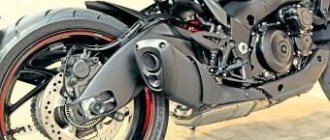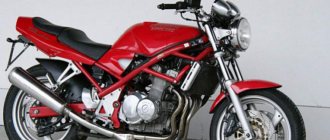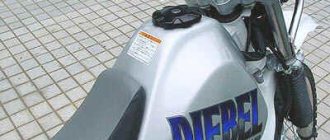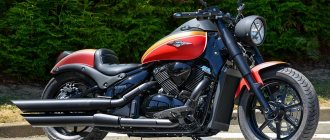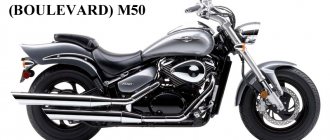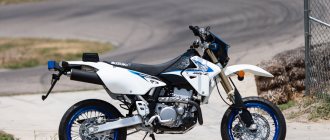- motorcycle model, Suzuki brand
The Suzuki DR 650 enduro motorcycle model appeared in 1990 as a result of modifications to the DR600 model and Suzuki's desire to compete with Honda with its NX650 Dominator model. The motorcycle was based on a simple 1-cylinder air-oil-cooled engine producing 46 hp. and 57 Nm of torque. The engine had 4 valves and 1 camshaft. Depending on the version, the launch was carried out using a kick or electric starter.
Main modifications of the Suzuki DR 650:
Suzuki DR 650 R (Djebel, Dakar) is a classic enduro with a single exhaust pipe and protective glass on the reflector.
Suzuki DR 650 RS is a touring enduro version with pronounced wind protection and a double exhaust pipe.
Suzuki DR 650 RSE - version is similar to the previous one, but with an electric starter, a more capacious battery and a more powerful generator. 15 kg heavier.
Suzuki DR 650 SE is an upgraded version of the Suzuki DR650R, which replaced it. It features a retuned engine (for better low-end traction), a stainless exhaust, suspension and a classic off-road enduro look. The problem of corrosion of the swingarm, frame and gas tank has been resolved. 25 kg lighter than the Suzuki DR650R.
In 1997, based on the engine from the Suzuki DR 650, a touring enduro model was released - the Suzuki XF 650 Freewind, which became a response to the European flagships - the BMW F650 and Aprilia Pegaso 650.
Today, the only model on the market is the Suzuki DR 650 SE, which is still officially produced and sold. In 2015, the company celebrated the 20th anniversary of the release of the Suzuki DR 650 SE. Since the motorcycle has remained virtually unchanged in terms of engine and still has a carburetor, it is practically not sold in Europe (due to Euro 3 emissions standards). Meanwhile, the Suzuki DR 650 SE is very popular in Canada, Australia and New Zealand, where it is among the top 5 best-selling motorcycles with an engine capacity of over 500 cc. cm.
Review of the Suzuki DR 650 motorcycle (R, RS, RSE, SE)
The motorcycle was very pleased with its dynamics (I compare it with large endurors), the engine loves to be turned... the first gear is very stretched, but I got used to it very quickly... I stuck the second closer to 40 km.h... the fifth is also stretched, I stuck it in after 110, when overtaking dialed up to 150..
A comfortable speed is about 120, I think a windshield and large mugs on the steering wheel will increase this number.
It is very easy to drive and predictable on light off-road conditions; it managed to mix slightly with the coastal Kama sands. The seat is wider than the jebel, but a bit harsh... every 150-200 km I stopped and warmed up... I will improve it in the winter. Tank 13l, of which 3l is reserve. The total range on one fill is about 200 km + 60 on reserve. Fortunately, an 18.5 liter tank is already available. Overall a very positive motorcycle! Predicted, minor improvements do not count.
I bought a Suzuki DR650SE motorcycle this year and have driven it a little, but I’ll already note
Pros:
Handling on ground and mud is comparable to 250s.
Comfortable seating, high ground clearance
Minuses:
High first gear, even on asphalt
Lack of crankcase protection
On the asphalt, due to the high seating position, you don’t feel comfortable, but enduro is enduro..
Operating experience since August 2006 has revealed the following disadvantages of the DR650 model:
1. a noticeably small tank - about 13 liters, when traveling to Blagoveshchensk it simply tormented me, and with my tuned engine and carburetor, consumption at 120 km/h is approaching 9 liters per hundred, I had to look for gas stations quite often..
2. steering column bearings, in ten years of enduro racing, this is the first motorcycle where the steering column bearings have fallen out... on all the DR and DRZ forums they claim that this is a disease... so you bought such a motorcycle, immediately lubricate the lower bearing and adjust.
3. Wheel bearings are just a joke, put 100 series bearings in the front axle of a 650, I already had 300 series on my moped. I’m generally silent about motorcycles.. in general, if you bought a DR650, keep an eye on the bearings, especially the front ones... get ready On a long journey, take a set of spare ones with you..
4. Rollers supporting the chain - they are on bushings, the bushings wear out and the chain begins to rattle disgustingly; they are already produced abroad on bearings with seals. I solved this problem by installing two carbon bearings.
Suzuki DR 650 SEK '05 (2005)
An excellent Enduro motorcycle. Was purchased in August 2011 with less than 700 miles. American. Oil Mobil 1 10w60. I took it specifically for driving around Sakhalin, I’ll say right away that the moto allowed me to literally drive through Sakhalin - up and down. I went everywhere where light enduros went.
The first pass from Vladivostok to Khabarovsk revealed the first disadvantages that make the motorcycle “difficult” for long-range passes:
1. The plastic muzzle raises the oncoming air flow and directs it directly into the pilot’s chest, blowing it strongly under the helmet! The noise was like a tank or an AN-2 plane!!
2. I got the motorcycle with a tuned “low” gel saddle. My 5th point was, to put it mildly, not happy about this.
In Khabarovsk, I solved both shortcomings by installing a plastic windshield and driving at maximum speeds became very comfortable. I pulled a 5 mm thick tourist hob onto the saddle with a net... and relief came
According to the characteristics, the weight of the motorcycle on highways and other dirt-shit surfaces is absolutely not annoying! But in difficult enduro rides on shifting and crumbly sands, swamps, seaweed, slippery stones in river beds - it’s quite stressful!
Especially with my non-heroic forms.
Saddle height. 860 (if memory remains unchanged). With my height of 168 cm, I’m a bit tall, in sneakers I could only reach the ground with my socks. But in enduro motorcycle boots or boots (+2 cm to height) I can stand with almost the entire foot, but, of course, there is no reserve of height and this played a cruel joke on me several times on difficult enduro routes. The suspension could be lowered by standard adjustments by 3 - 4 cm, but either I didn’t get around to it, or I rolled it in, but the moto never lowered it!
Engine, Volume, power and thrust.
The engine is reliable! Tested for yourself! It is convenient to check the oil level, there is a window that you just need to wipe from dirt
I didn’t appreciate the promised locomotive traction on stock stars. Yes, there is traction, long gears allow you to feel comfortable both on climbs and when crossing deep puddles and swamps. I always knew that there was a power reserve of the throttle under my right hand, and this clearly warmed my soul.
IMHO, to use it for enduro purposes, the sprockets need to be changed. and it will be now!
Maximum speed 95 miles. It was not possible to accelerate further on soft mud tires; the spiky pattern interferes. Moreover, for such anneals it is necessary to change the stars!!
The motorcycle gets onto the rear wheel very easily in first gear, but I couldn’t lift it into second gear, I need at least a speed bump! But in all gears, in the middle of the tachometer, there was ALWAYS enough torque to lift (unload) the front suspension and jump over an obstacle. (Working with the clutch, gas only up to 4th gear)
Suspension.
We can talk a lot about it for a long time, especially about the leaking rear shock absorber and riding on a spring! Fortunately, the shock absorber is DISMOUNTABLE!!! (this is also entertainment - not for the faint of heart!! Especially how it looks from the outside during high-speed passage of enduro routes - It’s really scary when the trunk rests between your shoulder blades immediately after leaving a small jump!)
The stock suspension is quite soft and comfortably handles the unevenness of asphalt roads; on the damp Lidoga-Vanino dirt road it was difficult to catch. For gravel roads with poor surfaces, as well as for high-speed enduro routes, the suspension needs to be made more rigid, fortunately there are possibilities for this in stock!
Separately about jumping - the moth jumps pretty well!! (For enduro) The suspension comfortably handles jumps from a height of up to half a meter! Especially if you land on two wheels at once!!
Conclusion:
After 4,500 miles, the bike showed its best side for the most part! Good traction, excellent acceleration, excellent suspension and a good resource and safety margin make the motorcycle very successful for long-distance enduro rides. Over the entire mileage, only the leaked shock absorber failed (the seal does not hold and requires replacement), but the complete repairability of the shock absorber makes this failure insignificant.
The downside is the weight (dry weight of the motorcycle is 147 kg), whether it’s a lot or a little is up to you to decide! For me personally, with my height of 168 and weight of 65 kg, this is the limit. Having gained some experience in dealing with this bike, the weight caused problems only on difficult enduro routes, otherwise it was a joy!!
Another feature, I don’t know if it’s good or bad, is that the steering wheel is attached to the upper crossbar! Bolted, with elastic bands. When you fall, the steering wheel moves relative to the wheel! And this requires quite a bit of effort!! No, while driving and hitting trees and bushes, the steering wheel does not move, but if the bike is dropped, then the steering wheel will definitely have to be put back in place, although this can be done by hand without any problems.
This feature can be treated by replacing the steering wheel and yoke. (price 6 - 15,000 rub.)
Yes, I almost forgot!! The stock Suzukovsky steering wheel is a complete mess, bent when it hits the asphalt lightly. Has been replaced by Fatbar from Zeta! — IMHO, super steering wheel! I really liked it, plus the Zeta Armor Band made riding through the bushes a real pleasure!
I got a lot of positive emotions from owning this motorcycle, I really liked the motorcycle. IMHO, I don’t see any analogues for such a long trip on difficult enduro routes!!! For others, I advise you to take a closer look at the Honda XR650L.
For local enduro grips, I recommend choosing a lightweight enduro. The only exception can be your heroic characteristics, if your height is more than 172 cm and your weight is more than 80 kg - you will like the motorcycle even more than me!
Brief history of the model
1990 - start of production and sales of the Suzuki DR650 series. There are 3 models on the market - Suzuki DR650S, Suzuki DR650R and Suzuki DR650RS. Model: Suzuki DR650S, Suzuki DR650R, Suzuki DR650RS. Factory designation: DR650RSL, DR650RUL, DR650RL, DR650SL, DR650RSUL.
1991 - the appearance of the Suzuki DR650RSE modification - distinguished by the presence of an electric starter and increased weight. Model: Suzuki DR650S, Suzuki DR650R, Suzuki DR650RS, Suzuki DR650RSE. Factory designation: DR650RSUM, DR650RSM, DR650SM, DR650RSEUM, DR650RSEM, DR650RUM, DR650RM.
1992 - appearance of the SE modification - differs from the Suzuki DR650S by the presence of an electric starter and increased weight. The RS version is no longer produced. The fuel tank is reduced from 21 to 17 liters. Model: Suzuki DR650S, Suzuki DR650SE, Suzuki DR650R, Suzuki DR650RSE. Factory designation: DR650RN, DR650RUN, DR650SN, DR650SEUN, DR650RSEN.
1993 - no significant changes. SE and RS versions are not produced. Model: Suzuki DR650S, Suzuki DR650R, Suzuki DR650RSE. Factory designation: DR650RP, DR650RUP, DR650SP, DR650RSEUP, DR650RSEP.
1994 - appearance of the RE modification - differs from the DR650R by the presence of an electric starter. Last year of production of the Suzuki DR650R. Model: Suzuki DR650R, Suzuki DR650RE, Suzuki DR650SE, Suzuki DR650RSE. Factory designation: DR650RUR, DR650RR, DR650SER, DR650RSEUR, DR650RSER, DR650R, DR650REUR, DR650RER.
1995 - Only SE, RE and RSE models are available on the market. Model: Suzuki DR650RE, Suzuki DR650SE, Suzuki DR650RSE. Factory designation: DR650SES, DR650RSEUS, DR650RSES, DR650REUS, DR650RES.
1996 - All versions except RSE are discontinued. The appearance of a new model - Suzuki DR650SE (1996+). The new model's engine produces less power but more torque with minimal vibration. The motorcycle also features a stainless exhaust, frame, swingarms and gas tank, new suspensions and a dry weight reduced by 25 kg. Suzuki DR 650 SE has the look of a classic off-road enduro. Model: Suzuki DR650SE, Suzuki DR650RSE. Factory designation: DR650SEUT, DR650SET, DR650RSEUT, DR650RSET.
1997 - The RSE model is no longer produced. There is only the new Suzuki DR650SE model on the market. Model: Suzuki DR650SE. Factory designation: DR650SEV, DR650SEUV.
1998 - Model: Suzuki DR650SE. Factory designation: DR650SEW, DR650SEUW.
1999 - Model: Suzuki DR650SE. Factory designation: DR650SEX, DR650SEUX.
2000 - Model: Suzuki DR650SE. Factory designation: DR650SEY, DR650SEUY.
2001 - Model: Suzuki DR650SE. Factory designation: DR650SEK1, DR650SEUK1. The fuel tank is reduced from 17 to 13 liters.
2002 - Model: Suzuki DR650SE. Factory designation: DR650SEK2.
2003 - Model: Suzuki DR650SE. Factory designation: DR650SEK3.
2004-2009 - Model: Suzuki DR650SE. Factory designation: DR650SEK4-DR650SEK9.
2010 - The Suzuki DR650SE model receives height adjustment. Model: Suzuki DR650SE. Factory designation: DR650SEL0.
2011-2017 Suzuki DR650SE. Factory designation: DR650SEL1-DR650SEL7.
Characteristics:
| Model | Suzuki DR650 (R, S, RS, SE) |
| Motorcycle type | enduro |
| Year of issue | 1990+ |
| Frame | steel |
| engine's type | 1-cylinder, 4-stroke |
| Working volume | 644 cc cm. – DR650SE 640 cc. see – DR650S, DR650R, DR650RS |
| Bore/Stroke | 100 x 82 mm – DR650SE 95 x 90.4 mm – DR650S, DR650R, DR650RS |
| Compression ratio | 9.5:1 – DR650SE 9.7:1 – DR650S, DR650R, DR650RS |
| Cooling | air-oil |
| Number of valves per cylinder | SOHC, 4 valves per cylinder |
| Fuel supply system | carburetor, 1x Mikuni BST40SS |
| Ignition type | electronic CDI |
| Maximum power | 43 hp at 6400 rpm - DR650SE 46 hp. at 6800 rpm - DR650S, DR650R, DR650RS |
| Maximum torque | 54 Nm at 4600 rpm - DR650SE 56.6 Nm at 5000 rpm - DR650S, DR650R, DR650RS |
| Transmission | 5-speed |
| type of drive | chain |
| Front tire size | 90/90-21 M/C 54S |
| Rear tire size | 120/90-17 M/C 64S |
| Front brakes | 1 disc 290 mm, 2-piston caliper – DR650SE 1 disc 280 mm, 2-piston caliper – DR650S, DR650R, DR650RS |
| Rear brakes | 1 disc 240 mm, 1-piston caliper – DR650SE 1 disc 230 mm, 2-piston caliper – DR650S, DR650R, DR650RS |
| Front suspension | telescopic fork (without adjustments), travel – 260 mm – DR650SE telescopic forks (without adjustments), travel – 240 mm – DR650S, DR650R, DR650RS |
| Rear suspension | monoshock absorber with progression (adjustable preload and rebound), stroke - 260 mm - DR650SE monoshock absorber with progression (adjustable preload and rebound), stroke - 220 mm - DR650S, DR650R, DR650RS |
| Dimensions of the motorcycle (LxWxH) | 2255 x 865 x 1205 mm – DR650SE 2250 x 870 x 1315 mm - DR650S, DR650R 2235 x 870 x 1345 mm - DR650RS |
| Seat height | 885 mm (845 mm - low seat) - DR650SE 890 mm - DR650S, DR650R, DR650RS |
| Maximum speed | 150 km/h |
| Gas tank capacity | 17 l - DR650SE (1996-2000); DR650R, DR650S, DR650RS (1992-1996) 13 l - DR650SE (2001+) 21 l - DR650R, DR650S, DR650RS (1990-1991) |
| Motorcycle weight (dry) | 147 kg - DR650SE 152 kg - DR650S, DR650R 155 kg - DR650RS |
| Motorcycle weight (curb) | 166 kg - DR650SE |
Test drive SuzukiDR 650 SE
The Suzuki DR650 is known much more overseas than here. In addition to serving in the US Army, it is widely used for weekend rides in areas from the steppes of Mexico to the ice of Alaska. But this is rather a consequence. So what is the reason for the popularity of a model that is not the most successful at first glance? It was summer. Getting ready for the test drive, or rather, already slightly late and pulling on my motocross helmet as I went, I looked skeptically at my leather all-season gloves, and then at the thermometer, which gloatingly showed +30 in the shade. After hesitating for a second, I decided to leave them at home - it seemed like I was going to test the enduro, and there was standard hand protection - it would be good to go. As it turned out, I was in no hurry - the owner of the Suzuki DR650 was clearly in no hurry to get to the meeting. To pass the time, I began to remember everything I knew about this model.
Its history is very extensive. The founder of the DR clan was the 400 cc model, which was released 29 years ago. The first “six hundred” was shown at an exhibition in 1984, and by the end of the 80s it was already beloved and revered on the market. But by that time, Honda had launched the NX650 Dominator series, so Suzuki had no choice but to carry out an “upgrade” and release the new DR650 to the public in 1990. This motorcycle came in two forms: the DR650 Djebel (called the DR650 R Dakar in some markets) and the DR650 RS. The latter was 9 kilograms lighter, had a different exhaust system, a semi-fairing and a low wing - it was intended for civilian use, so it did not even have areas for racing numbers.
In 1991 the DR650 RSE appeared. It was heavier than the RS by as much as 15 kilograms, but it had an electric starter, a capacious battery, and a 200-watt generator instead of the previous 180 - this was the second step towards road use. In 1992 and 1995 there was a small facelift of the entire line, but the following year the DR650 SE appeared with a significantly redesigned engine and chassis. He lost 25 kg and was definitely leaning towards off-roading. Actually, this motorcycle has not undergone significant changes since then. From the memorable 1996 to 2004, only the graphics and the shape of some body kit elements changed.
Oh, and here is the owner, with his latest generation DR! According to the plan, we had to go deep into the forest with a visit to the "goven", so it was decided to arrange a preliminary photo session before the motorcycle was covered with a layer of mud two fingers deep. Clicking the camera, I couldn’t help but notice the visual cycling and spartan design of the DR. A simple steel frame holds a 650 cc carburetor air vent with a small oil cooler. Moreover, the lubrication system here is with a “wet” sump! And this is on enduro, which is quite rarely in an exclusively horizontal position! Whatever you say, it’s a strange decision. Pendants – materialized budget. At the front there is a non-adjustable fork with a stay diameter of 43 mm, at the rear there is a monoshock absorber with preload adjustment, working in tandem with a lever system. This kit is not enough to conquer tough off-road conditions, and the dry weight of 147 kg is generally depressing. I remember that on the DRZ 400S the suspension is much more serious, the weight is less, and the power is almost the same.
According to the classification, DR is a typical “soft” without any “hard” or “sport” - there’s not even a kick, just an electric starter, so the motorcycle is traditionally a button. The only serious things here are the Race Tech tuning hand protection (as I knew, you don’t need to take gloves) and full-fledged Pirelli MT21 motocross tires. The instrument panel is made in the spirit of Soviet minimalism, which turned out to be international - speedometer, odometer and several indicator lamps. Enough for driving.
So, what kind of bullshit is this? Steering weights? Enduro?! I won’t lie, the Japanese managed to surprise me. What do typical road attributes do on an off-road bike? Did you run away from your tourer with a wet sump and get lost?
Jumping into the saddle, I felt like I was sitting on a garden bench - the height from the fifth point to the ground is only 845 mm, even without taking into account the fact that the pendants sank significantly under the weight of my 85 kilogram carcass. Such loyalty to short riders makes the process of conquering windbreaks, rockfalls and other “shit” convenient.
The hot engine started up at half speed, filling the silence of the forest with an optimistic bass murmur. Having squeezed out the soft clutch, I put the first one in and go, go!
The visual feeling of “cycling” was justified a hundred times over - thanks to the short wheelbase, the handling is very sharp, almost like on cross-country motorcycles, and the considerable weight (as for an enduro) ceases to be felt as soon as you put your feet on the “toothy” pegs. The seat here is “correct” - that is, it can compete in hardness with a particle board. But it is very convenient for an active riding style, when you have to use the body to change the weight distribution of the motorcycle along the axes.
Moving closer to the tank and smoothly but confidently pressing the front brake with two fingers, you immediately feel that the rear wheel has “taken off.” The rear brake is good in hairpin turns - 180-degree turns. A slight press and the tail predictably moves to the side, directing the motorcycle onto the right trajectory.
In general, the brakes have good performance and informativeness, and thanks to the cross-country tires, they are excellent on any surface (except asphalt). During the next series of bends in the forest road, I tried to accelerate the motorcycle into a turn and noted with regret that at the bottom the engine did not pull at all and did not want to enter a power skid. As it turns out, it doesn’t like high speeds either, noticeably “deflating.” But, after just a few minutes, it was possible to develop a mutual understanding with the engine, which consisted of riding “on the moment” - in this case, both skidding and wheelies are not a problem, and the motorcycle flies out of turns like a cork from a bottle.
Despite this, an unpleasant aftertaste still remained - no joke: it’s almost a seven hundred cc “pot”, but it drives like a “four hundred”. The acceleration is quite fast, but the response to gas is slow due to the use of an outdated carburetor in the power system. However, soft enduro doesn’t need this - it’ll scare the lightning-fast reaction of some phlegmatic summer resident rider carrying his mother-in-law, daughter, skis and a bag of potatoes.
The gearbox, how shall I put it... in general, just works. It just works, that's all. The downsides are frequent mismatches and too pronounced neutrality. To guarantee a switch from the first to the second, the box needs to be given a good kick - what’s most interesting is that it doesn’t mind this at all.
A series of jumps revealed the potential of the pendants. Despite my concerns, there is quite good potential. Thanks to the large travel (260 mm) of the suspensions and their good energy consumption, they did not break on landings, and they behaved quite adequately on the “washboard”, thanks to successful factory settings. But during active maneuvering between ruts stretching along the road, with periodic jumps into them, insufficient chassis rigidity appeared. I can’t call the frame “plasticine”, but it seems that there is still an admixture of this wonderful structural material in it. In addition, the effect was aggravated by a rather weak fork in torsion (hello 43 mm!). Finding itself on a chaotically rutted area, the motorcycle, offended by my skepticism, lay down, and I, by inertia, made a spectacular somersault over my head. I had to quickly get up and press the engine “stop” button so that the engine would not thresh “dry” (and what smart guy came up with the idea of a “wet” sump on enduro?!).
As it turned out, the steering weight protruding beyond the protection played the role of an anchor and bent the mounting bolt, and the (seemingly powerful) Race Tech itself turned out to be screwed through a thin metal plate, which did not fail to bend. Kindergarten, not protection! I’m ready to answer for my words, as I’ve repeatedly tried it on my less off-road KTM990 Adventure with a complete absence of damage.
After a certain number of minutes, the “pilot” on the ATV reported that the road ahead was blocked with logs and branches, so we would break straight through the underbrush. This is where DR won back on points. Thanks to the huge turnout of the steering wheel, the low saddle and the relative ease of control, it was very easy to push through the windfall. I think that with a certain dexterity of the rider, the motorcycle will beat the quad in this discipline, due to its much smaller width. Having made a detour and again getting out onto a flat forest road, I rushed forward, cooling myself and cooling the engine. It is worth noting that heat dissipation on the DR is quite good and it is quite difficult to overheat the engine.
Soon the flagship ATV caught a suspiciously properly sharpened and sanded knot with its wheel. Having sealed the hole, it was decided to return without ever reaching the coveted “shit” - especially since it was already getting dark in the forest. The DR's head light turned out to be expectedly weak, but this is typical for the entire enduro class, with the possible exception of the Honda Baja series with its huge “spotlights”.
In addition, it was decided not to drive on asphalt - there is nothing to “catch” on cross-country tires either in the city or on the highway, and the braking dynamics, so excellent on the ground, almost disappear, turning driving into an unpleasant and unsafe experience.
Well, the time has come to answer the question I asked myself in the introduction. Why is DR so popular there and little known like enduro here?
So what do we have? Simple chassis, simple engine, easy handling and calm character. It is precisely because of the simplicity of the design that this motorcycle is phenomenally repairable in field conditions, and the absence of the complex impulsive character of hard enduro and the forgiving attitude make it understandable to beginners and suitable for utilitarian use (bringing a bale of hay or a bag of potatoes from the dacha is no problem). This is the reason for the popularity of "there". The reason for the cold reception of the model here is its price. For example, for almost the same money you can buy a more high-tech Suzuki DRZ400 (S or E - depending on your goals and temperament). But, DRZ, unlike DR, is less friendly to novice short riders, and it also likes mud and windbreaks not so much.
Despite my slightly unflattering review of the model, I returned from the test drive in a good mood and with memories of something pleasant - apparently, “DR” managed to “hook” me. After all, the owner of a dachshund doesn’t complain that his dog can’t bite through hand-thick sticks!
Text: Sergey Kuznetsov
Photo: provided by the author
